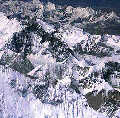One of the first things Edmund Hillary did when he reached the top of Mount
Everest half a century ago was to photograph the scene to prove he and climbing
mate Tenzing Norgay Sherpa were first.
 Somewhere on the vast mountain is another camera that
may prove they were not.
Somewhere on the vast mountain is another camera that
may prove they were not.
In 1924, Britain's most accomplished climber of his day, George Mallory,
and partner Andrew "Sandy" Irvine disappeared after last being seen "moving
expeditiously" toward the summit, sparking mountaineering's most enduring
mystery:
Did they die on the way to the top or on their way back?
"The conundrum that elevates Mallory and Irvine's vanishing act to the
realm of the mythic is the possibility that the pair could have reached the
summit," Conrad Anker, who found Mallory's body in 1999, wrote in his book, "The
Lost Explorer."
The answer may lie on the film inside the missing Kodak camera
37-year-old Mallory took with him.
Mallory's body was found frozen into the scree at 26,700 feet, his
fingers dug in as if trying to stop a fall, a tattered, broken rope around his
waist and his body mummified to a marble white by the sub-freezing temperatures.
His skull was cracked, his right leg badly broken and he appeared to have
died in a long fall, Anker wrote.
Anker and his colleagues found Mallory's pocket knife, his altimeter, a
monogrammed handkerchief and even a tin of beef lozenges. But no camera and no
backpack.
No one knows if the camera was lost in the fall or if it could be with
Irvine's body, still somewhere on the mountain.
And nor can anyone be sure that even if the camera were found, it would
still be possible to develop pictures.
"I can't give a definite answer by saying 'yes' or 'no'," James Blamphin,
spokesman for Eastman Kodak Company in New York, told Reuters. "It's very
difficult to comment without seeing the condition of the camera."
'GREAT MYSTERY'
Hillary, now Sir Edmund and 83, does not care if his hero Mallory -- who
made the famous quip he wanted to climb Everest "because it is there" -- was
first.
"It's a great mystery," Hillary, who looked for signs Mallory had been
first when he reached the summit in 1953, told Reuters in Kathmandu during last
month's 50th anniversary celebrations.
"Who knows? Mallory may have reached the summit. Probably he didn't. But
he certainly did not reach the bottom.
"So, whatever happens, although he is a heroic figure, he didn't quite
complete the job."
Mallory's 1924 expedition, his third to Everest, remains one of the
world's greatest climbing feats.
With Irvine, a relatively inexperienced 22-year-old, Mallory set out for
the summit from a staging camp on June 8.
They were climbing on the northern side, from Tibet, because the easier
southern route used by Hillary and Tenzing almost three decades later was in
Nepal, then closed to foreigners.
Their gear was primitive: hobnail boots with nails sticking out of the
sole instead of crampons; cumbersome oxygen systems which Irvine tinkered with
constantly to try to improve; and fragile cotton ropes that would be
unacceptable now.
Against the bitter temperatures, they wore seven or eight layers of
mainly woolen and waterproof gabardine clothing.
When they were last seen they had come as close as 150 vertical yards
below the 29,035 feet summit.
When a modern expedition tried to climb in similar clothes and with
similar gear a few years ago, they did not get very far before the cold forced
them to turn back.
Approached from the northeast ridge, the top of Everest is protected by a
sheer, 90-foot wall, the Second Step.
This wall defeated all comers until 1960, when a Chinese team claimed to
be the first to summit from the North after climbers stood on each other's
shoulders to pass the Second Step. Most experts dispute that summit claim.
It wasn't until 1975 that another Chinese expedition reached the summit
by rigging a ladder up the step -- which most climbers still use today.
BODY SEEN
Despite Mallory's natural skills, most experts believe it unlikely he and
Irvine could have reached the summit with their primitive equipment and limited
and leaky oxygen supply.
"The clincher is the Second Step," said Anker. "In my heart, I've always
wanted to believe Mallory and Irvine reached the summit in 1924. It would have
made for one of the ultimate of all mountaineering tales.
"But ... I believe there is no possible way."
Still, recent revelations by a member of the 1960 Chinese team that he
had seen a body at 27,200 feet -- which could only have been Irvine's -- are
likely to inspire more searches.
"There's just a tiny iota of a chance it will ever be solved," said
Kathmandu-based mountaineering historian Elizabeth Hawley. "But in a way, maybe
it's better if it's not."
